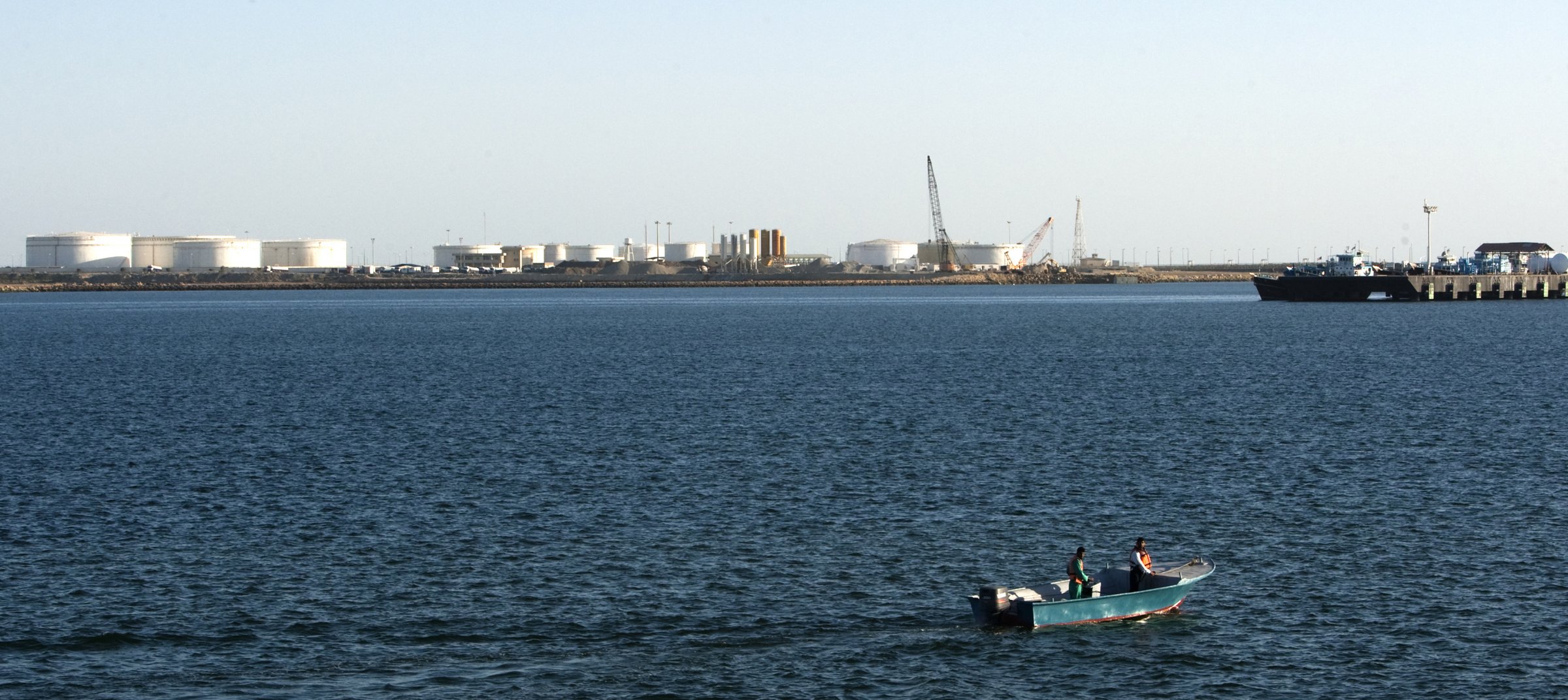 A speed boat passes oil docks at the port of Kalantari in the city of Chabahar, 186 miles east of the Strait of Hormuz, January 17, 2012.REUTERS/Raheb Homavandi
A speed boat passes oil docks at the port of Kalantari in the city of Chabahar, 186 miles east of the Strait of Hormuz, January 17, 2012.REUTERS/Raheb Homavandi
- India is working with Iran to develop and overland route to Afghanistan.
- The US, which wants India’s help in Afghanistan, appears to have accepted that India and Iran will have some kind of relationship going foward.
- India is also trying to build influence around the Indian Ocean.
Just days after the first shipment of Indian wheat arrived in the southeastern Iranian port of Chabahar on its way to Afghanistan, Indian officials said they were in talks with Tehran to begin interim operations at the port.
India’s activity at Chabahar is more than a decade in the making, but the country now finds itself steering between its own rival in Pakistan and an arch US foe in Iran in order to reach Afghanistan, where the Trump administration is eager to see New Delhi offer economic and security assistance.
India’s and Afghanistan’s foreign ministers heralded the first of seven shipments of 1.1 million metric tons of wheat headed to the latter country.
“The shipment of wheat is a landmark moment as it will pave the way for operationalisation of the Chabahar port as an alternate, reliable and robust connectivity for Afghanistan” and “enhance trade and commerce between the three countries and the wider region,” India’s Ministry of External Affairs said in a statement.
 Google Maps
Google Maps
India signed the Chabahar Agreement with Afghanistan and Iran in spring 2016, allowing India to access Afghanistan through the port. India has committed $500 million to develop the port, alongside plans for overland-transit routes, including a railway for which India has said it would supply $400 million worth of steel rails.
Washington is keen to see India do more to help stabilize Afghanistan, where the Trump administration has recommitted the US to its 16-year-long war. Earlier this year, Trump appeared to to tie India’s trade relationship with the US to its role in Afghanistan, and his administration has withheld hundreds of millions from Pakistan in order to get it to do more to secure the war-torn country.
India also has its own interest in developing new routes to Afghanistan.
India is Afghanistan’s top destination for exports, receiving $220 million of the latter country’s $483 million in total trade in 2016, according to The Diplomat. A significant portion of Afghanistan’s manufactured goods have traveled through Karachi in Pakistan on their way to India; however, deteriorating relations with Islamabad have severely crimped that flow.
Pakistan has had poor relations with India and Afghanistan, and it does not allow those two countries to use its territory for overland trade. Pakistan has also accused India of using Afghanistan as a base from which to undermine Pakistan — though a Pakistani Foreign Office official reportedly said this week that Islamabad does not see India-Afghanistan trade via Iran as “any kind of alliance against us.”
Developing an overland route through Iran is also a potentially touchy subject with the US.
 President Donald Trump with Indian Prime Minister Narendra Modi during a joint news conference at the White House, June 26, 2017.REUTERS/Kevin Lamarque
President Donald Trump with Indian Prime Minister Narendra Modi during a joint news conference at the White House, June 26, 2017.REUTERS/Kevin Lamarque
New Delhi has framed its engagement with the Chabahar project as more about reaching Afghanistan than about building ties with Iran, and India has in the past cut its oil imports from Iran in response to international sanctions.
And Washington appears to be assenting to limited cooperation between India and Iran. Secretary of State Rex Tillerson said during a visit to India in October that the US would not block projects to help Iranians (though he stressed that the US would act against financial benefits reaped by Iran’s Revolutionary Guard Corps).
Jeff Smith, a South Asia expert at The Heritage Foundation in Washington, told Reuters he had the impression conservative analysts in the US “have accepted” that India and Iran will maintain some kind of relationship.
“They recognize that for India, Iran is more about a transport corridor to Afghanistan; that it has no interest in advancing Iran’s agenda in the Middle East; and that whatever space India evacuates there will be filled by China,” Smith said.
Balancing against China in the Indian and Pacific Oceans is an important goal for the US and India, but perhaps more so for India.
 Indian sailors aboard INS Kadmatt arrive for a four-day goodwill visit, aiming to strengthen ties between India and the Philippines, in Manila, October 3, 2017.REUTERS/Romeo Ranoco
Indian sailors aboard INS Kadmatt arrive for a four-day goodwill visit, aiming to strengthen ties between India and the Philippines, in Manila, October 3, 2017.REUTERS/Romeo Ranoco
China has in recent years developed a string of bases and ports along the Indian Ocean coast and signed on to infrastructure deals with countries in the region — ranging from Bangladesh to Myanmar to Sri Lanka to Pakistan to Djibouti.
India appears to be taking a more muscular approach to defending its interests in the region, expanding its weapons purchases — particularly of naval armaments — and investing in its domestic defense industry.
While India remains wary of Chinese activity along their shared northern border, its attention now appears to be turning to its southern, maritime approaches.
“This is a tectonic shift in India’s security calculus, that it has to protect its southern flank,” Brahma Chellaney, a strategic-studies professor at the Center for Policy Research,toldThe New York Times this summer.













